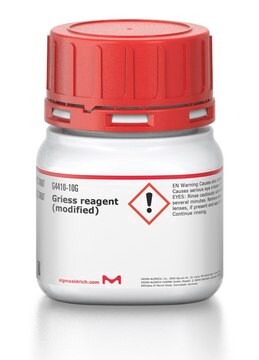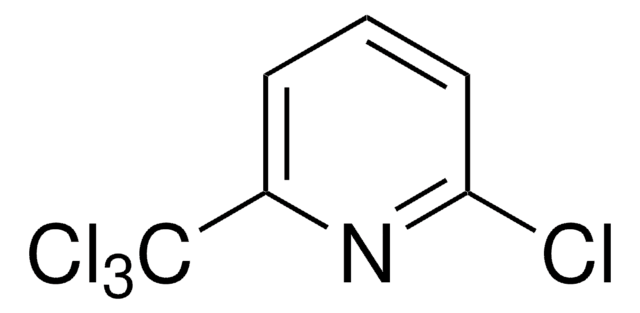N9125
N-(1-Naphthyl)ethylenediamine dihydrochloride
≥98%
Synonym(s):
2-(1-Naphthylamino)ethylamine dihydrochloride
Sign Into View Organizational & Contract Pricing
All Photos(3)
About This Item
Linear Formula:
C10H7NHCH2CH2NH2 · 2HCl
CAS Number:
Molecular Weight:
259.17
Beilstein:
3707471
EC Number:
MDL number:
UNSPSC Code:
12352100
PubChem Substance ID:
NACRES:
NA.22
Recommended Products
Quality Level
Assay
≥98%
form
powder
mp
194-198 °C (dec.) (lit.)
SMILES string
Cl.Cl.NCCNc1cccc2ccccc12
InChI
1S/C12H14N2.2ClH/c13-8-9-14-12-7-3-5-10-4-1-2-6-11(10)12;;/h1-7,14H,8-9,13H2;2*1H
InChI key
MZNYWPRCVDMOJG-UHFFFAOYSA-N
Looking for similar products? Visit Product Comparison Guide
Related Categories
General description
N-(1-Naphthyl)ethylenediamine dihydrochloride is an organic compound with a conjugated ring structure that serves as a strong electron donor in charge transfer complexes. Its free base, also known as Bratton-Marshall reagent, is widely used in diazotization coupling reactions for detecting nitrites and nitrates.
Application
N-(1-Naphthyl)ethylenediamine dihydrochloride can be used as a reactant to synthesize:
- N
- -(1-naphthyl)ethylenediamine-substituted cylotriphosphazene derivatives as potential antimicrobial agents.
- Fluorescent chemosensor compound with a naphthyl group as fluorophore and cyclen as metal ion chelator for the detection of Zn(II) in an aqueous solution.
- (N-1-Naphthyl-ethylenediamine)- dichloroplatinum(II) fluorescence complex (λmax = 405 nm).
Signal Word
Warning
Hazard Statements
Precautionary Statements
Hazard Classifications
Eye Irrit. 2 - Skin Irrit. 2
Storage Class Code
11 - Combustible Solids
WGK
WGK 3
Flash Point(F)
Not applicable
Flash Point(C)
Not applicable
Personal Protective Equipment
dust mask type N95 (US), Eyeshields, Gloves
Choose from one of the most recent versions:
Already Own This Product?
Find documentation for the products that you have recently purchased in the Document Library.
Customers Also Viewed
Improved dye procedure for determining urea concentration by using o-phthalaldehyde and naphthylethylenediamine.
N T Lequang et al.
Clinical chemistry, 33(1), 192-192 (1987-01-01)
P K Laikind et al.
Analytical biochemistry, 156(1), 81-90 (1986-07-01)
The Bratton-Marshall reaction can be used to identify patients with adenylosuccinate lyase deficiency. These patients excrete in their urine the dephosphorylated derivative of the de novo purine synthesis intermediate 5'-phosphoribosyl-4-(N-succinylcarboxamide)-5-aminoimidazole (SAICAR). The test described here depends on a coupling reaction
C E Davis et al.
Journal - Association of Official Analytical Chemists, 68(3), 485-488 (1985-05-01)
Current methods used for determining residual nitrite concentration in foods involve forming an azo dye that is measured spectrophotometrically. Conventional procedures do not specify control of pH for the final colored solution. Because many indicator dyes are pH-dependent, absorbance of
Shigenori Nakano et al.
Talanta, 81(3), 786-791 (2010-03-20)
A novel flow-injection spectrophotometry has been developed for the determination of molybdenum(VI) at nanograms per milliliter levels. The method is based on the catalytic effect of molybdenum(VI) on the bromate oxidative coupling of p-hydrazinobenzenesulfonic acid with N-(1-naphthyl)ethylenediamine to form an
R K Goldman et al.
Analytical biochemistry, 259(1), 98-103 (1998-05-30)
A high-pressure liquid chromatography (HPLC) assay for measuring picomole quantities of nitrosothiol in biological samples was developed. The assay utilizes the catalytic reduction of nitrosothiol by mercuric cation (Hg2+). Released nitrogen oxide reacts with sulfanilamide (SA) and N-(1-napthyl)ethylenediamine (NNED) to
Our team of scientists has experience in all areas of research including Life Science, Material Science, Chemical Synthesis, Chromatography, Analytical and many others.
Contact Technical Service












